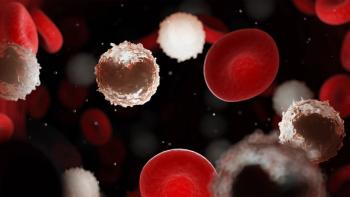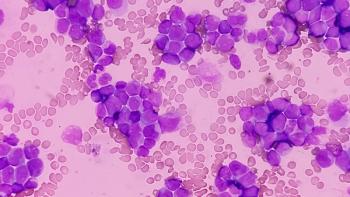
Upifitamab Rilsodotin May Answer Questions in Platinum-Resistant Recurrent Ovarian Cancer
An expert from Arizona Oncology discusses the unmet need for agents to address recurrent ovarian cancer and how upifitamab rilsodotin, an antibody-drug conjugate with promising preclinical and clinical data, may play into the treatment paradigm.
In both preclinical and clinical trials, the antibody-drug conjugate (ADC) upifitamab rilsodotin (XMT-1536, UpRi), has demonstrated promising performance in treating patients with recurrent ovarian cancer, according to Bradley J. Monk, MD, FACS, FACOG.
Upifitamab rilsodotin is a first-in-class ADC that targets the sodium-dependent phosphate transport protein NaPi2b, an antigen that is broadly expressed in ovarian cancer. The payload molecules per antibody are higher than that of other ADCs.
Investigators in the ongoing phase 1 UPGRADE trial (NCT04907968) are exploring the agent in combination with other ovarian cancer therapies for patients with platinum-sensitive high-grade serous ovarian cancer previously treated with 1 to 2 prior platinum-based regimens.
“The highest unmet medical need is platinum-resistant recurrent ovarian cancer,” Monk said. “In fact, since the FDA approval of bevacizumab [Avastin] in 2014, we have no new agents. We need to continue to push in both platinum-sensitive and platinum-recurrent disease, but platinum-resistant disease has the highest unmet need.”
In an interview with Oncology Nursing News®, Monk, professor in the Division of Gynecologic Oncology at Arizona Oncology, University of Arizona College of Medicine, Creighton University School of Medicine at St. Joseph’s Hospital; medical director of the Gynecologic Program of the US Oncology Research Network; and co-director of GOG Partners, discussed the unmet needs for patients with ovarian cancer and the clinical trials that are seeking to address those needs, including the ADC upifitamab rilsodotin.
Oncology Nursing News®: To start, could you speak about the unmet needs that exist in treating patients with platinum-resistant ovarian cancer, as well as patients with platinum-sensitive disease in the progress on a PARP inhibitor in the maintenance setting?
Monk: Recurrent ovarian cancer remains a high unmet need because [essentially] every patient who gets it dies. It is a terminal condition. We have historically bifurcated into 2 groups, platinum-resistant [disease] and platinum-sensitive [disease, and we’ve] evolved that terminology into those who are eligible for platinum and those who aren't. When patients respond to platinum [chemotherapy], generally the platinum doublet liposomal doxorubicin, but sometimes paclitaxel or gemcitabine with or without bevacizumab and sometimes with a PARP inhibitor in the maintenance [setting] is effective.
[When the regimens are effective] that’s great, but it's not enough because those patients ultimately recur over and over again and die of their disease. The highest unmet medical need is platinum-resistant recurrent ovarian cancer. In fact, since the FDA approval of bevacizumab in 2014, we have no new agents. We need to continue to push in both platinum-sensitive and platinum-recurrent disease, but platinum-resistant disease has the highest unmet need.
You mentioned that it's been a while since any new developments have been made. How are new agents, especially ADCs, being developed in ovarian cancer and how is their mechanism of action unique?
There are a number of approaches to develop effective and tolerable medicines in platinum-resistant recurrent ovarian cancer—at least 4 come to mind. Tumor treating fields are active in chemotherapy-resistant tumors such as glioblastoma multiforme in thoracic mesothelioma. Gene therapy is another [approach] which is being actively evaluated in the phase 3 OVAL study [NCT03398655] with ofranergene obadenovec [VB-111]. Then there are some novel cytotoxics that continue to be developed.
The biggest excitement is ADCs, [which] have been in the clinic for some time. They were initially developed in liquid tumors and now are available in breast cancer, gastric cancer, and even epithelial cancers and soon ovarian cancer. Additionally, cervical cancer because on September 20, 2021, an ADC tisotumab vedotin [Tivdak] was approved by the FDA. ADCs are where the excitement is, not only in liquid tumors, but other solid tumors. The first breakthrough was cervical cancer, but we're excited to see what the opportunity is in ovarian cancer.
What is the rationale for the use of ADCs in patients with recurrent ovarian cancer?
The goal of an ADC is to optimize the therapeutic index through targeting and design of the therapeutic. An ADC consists of 4 key components: the target, the antibody, the payload, and the linker. The antibody binds to a target, it has a payload, and that payload is attached with a linker. The idea is that the antibody binds to a tumor antigen that is overexpressed in the tumor microenvironment, generally right on the tumor and increases the concentration of the ADC in the tumor.
At that point, the linker disassociates, and the cytotoxic is delivered to the microenvironment, both at the site of delivery and as a bystander effect. Occasionally, the linker can become unstable, such as in the eye, and the toxic agent or the payload can disassociate and cause eye toxicity. There are other adverse reactions where the target is in other cells beyond the tumor such as the lung and can cause pneumonitis. We understand how, why, and when these medications work and how to mitigate the adverse reactions.
There are a 2 main targets for antibody drug conjugates in ovarian cancer, certainly there are others, but there are 2 that are being actively developed. NaPi2B, which is a sodium phosphate transport molecule, is being developed by a medication called upifitamab rilsodotin. There's another medication mirvetuximab soravtansine, which targets the folate receptor–alpha (FRα). There are other targets, but probably NaPi2B in the FRα are the furthest along.
Regarding mirvetuximab soravtansine (IMGN853), on November 30, there was a press release on the phase 3 Soraya study [NCT04296890]. The Soraya study is an opportunity to provide accelerated approval for mirvetuximab soravtansine. [In the study], 106 patients were enrolled, with up to 3 prior lines of therapy, and all folate receptor-high by the Ventana FOLR1 [Folate Receptor 1/Folate Receptor Alpha] assay. All patients had received prior bevacizumab, and prior PARP inhibitors were allowed.
Among those 106 patients, the blinded independent radiologic overall response rate was 31.6% with 5 complete responders and a median duration of response of 5.9 months [95% CI, 5.6-7.7]. This will probably be the first ADC that comes to the clinic, [and will hopefully be] approved by the FDA in 2022.
The treatment-related adverse effects were blurred vision, 41% all grade, but only 6% grade 3 or worse. Keratopathy grade 3 or worse [was observed in] 9% [of patients] and nausea. There were some dose reductions in 19%, but only 7% discontinued treatment. ADCs are here to stay [and are] already approved in cervical cancer, soon to be approved in ovarian cancer against the folate receptor, and NaPi2B will be the next wave.
Could you explain more about NaPi2B so far and why it is so promising in terms of being a potential treatment option?
UpRi is a humanized monoclonal antibody with a specific linker, a payload of auristatin and ultimately, a drug antibody ratio which is high. The number of payloads per antibody generally is 4. The drug to antibody ratio for UpRi is 10. This auristatin DolaLock is a controlled bystander effect, where it allows the payload to be selectively released within the tumor. There's strong preclinical evidence for that, and now there is clinical evidence for that.
We've worked hard to optimize the dose. What happens here is that the patients are on treatment for an extensive amount of time. As result of that, we have optimized the dose in a way that patients can remain on treatment. This is an exciting opportunity. This study is called the phase 1/2 UPLIFT trial [NCT03319628], and it is open around the country through the Gynecologic Oncology Group. If you want to enroll your patients or if you want to open this study, you can let us know.
Could you discuss what these studies are looking at and how they have progressed so far?
The pivotal UpRi trial called UPLIFT, or GOG 3048, will enroll 180 patients, ideally 100 patients with high NaPi2B expression, although all comers will be enrolled initially. The next study, which is ongoing, is called UPGRADE [and] adds UpRi to carboplatin in a rational way because there's an opportunity to examine combinations with UpRi.
Ultimately, we're doing a third study called the phase 3 UPNEXT trial [NCT01847274], which is a maintenance trial. Bevacizumab is being used earlier and earlier since the FDA approved [the agent for these purposes in] June 2018. PARP inhibitors are also being added earlier and earlier, first based on the phase 3 SOLO-1 [NCT01844986] in patients [who harbor] BRCA mutations, and ultimately the phase 3 prima trial [NCT02655016], approved in April 2020 in all comers, niraparib [Zejula].
Then olaparib [Lynparza] and bevacizumab were approved [in combination] in May 2020. That has created this unmet need [in the maintenance setting] in platinum-sensitive relapsed ovarian cancer. This idea of maintenance treatment because treating in the maintenance setting is still viable.
We're doing UPNEXT as a platinum-sensitive maintenance opportunity for UpRi. This is an exciting study because the existing medicines, PARP inhibitors and bevacizumab, are being moved into the first-line [setting] and now we have optimized the dose so patients can remain on treatment in this maintenance opportunity for an extended period of time, hopefully helping them live longer and also helping them live better.
Is there anything else that you would like to add?
The beauty of ADCs is that they selectively target a tumor-specific antigen in the tumor. However, if the overexpression is so rare, then the opportunity is limited. The best opportunity in cervical cancer is tisotumab vedotin, where the target, which is tissue factor, is ubiquitous in cervical cancer, so there is no biomarker. We've learned a lot about the FRα, which is only expressed in a fraction. Generally, it's a high fraction, but it's less than half. NaPi2B, although ubiquitous, probably also requires a biomarker.
The challenge here is that we do not exactly know the threshold or the cutoff. Again, we want the biomarker to be effective in predicting activity, but not so restrictive that the opportunity is limited. In UPLIFT, all patients are enrolled to evaluate the value of the biomarker and although I like biomarkers a lot, the best situation is where the target is so ubiquitous, like tisotumab vedotin, that you don't need it. We'll have to see with UPLIFT I think we figured it out with Suraya and ultimately mirasol with UpRi.
This article was originally published on OncLive as “Upifitamab Rilsodotin Has Potential to Address Unmet Need in Recurrent Ovarian Cancer”
Newsletter
Knowledge is power. Don’t miss the most recent breakthroughs in cancer care.
















































































